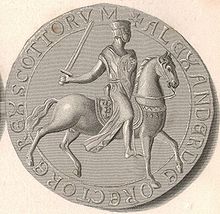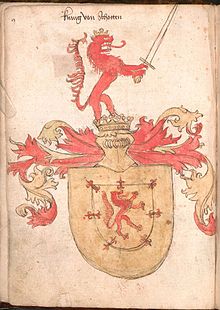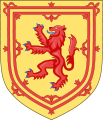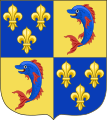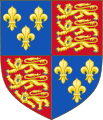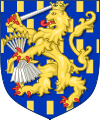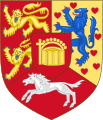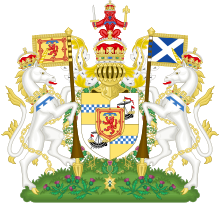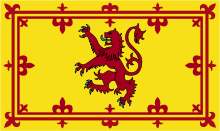- Royal coat of arms of Scotland
-
Royal coat of arms of the Kingdom of Scotland 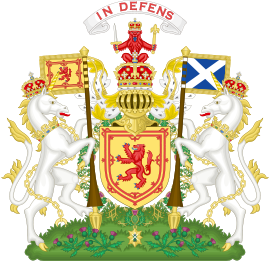
Versions 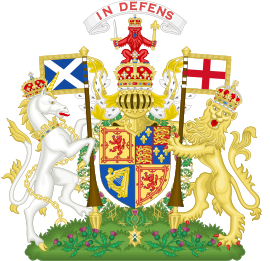
Coat of arms of James VI from 1603 as Jacobus primus britanniae franciae et hyberniae rex.Details Armiger James VI, King of Scots, ultimate armiger of pre-1603 version Adopted Late Middle Ages Crest Upon the Royal helm the crown of Scotland Proper, thereon a lion sejant affronté Gules armed and langued Azure, Royally crowned Proper holding in his dexter paw a sword and in his sinister a sceptre, both Proper Escutcheon Or a lion rampant Gules armed and langued Azure within a double tressure flory-counter-flory of the second Supporters Unicorns Argent Royally crowned Proper, armed, crined and unguled Or, gorged with a coronet of the second composed of crosses patée and fleurs de lis a chain affixed thereto passing between the forelegs and reflexed over the back also of the second. Sinister holding the standard of Saint Andrew, dexter holding the banner of the Royal arms Compartment a compartment underneath from which issue thistles one towards each side of the escutcheon Motto Scots: In My Defens God Me Defend (abbr. In Defens) Orders The Most Ancient and Most Noble Order of the Thistle. (Arms feature the collar of the order) Earlier versions 



Use Prior to the Union of the Crowns, 1603 The royal coat of arms of Scotland (commonly referred to as the Royal Arms of Scotland) was the official coat of arms of the monarchs of Scotland, and was used as the official coat of arms of the Kingdom of Scotland until the Acts of Union of 1707. The blazon of the arms of the Kingdom of Scotland changed markedly following the Union of the Crowns in 1603, and ultimately went on to become the Royal Coat of Arms of the United Kingdom as used in Scotland.
Contents
Features
The pre-Union of the Crowns version of the arms feature a shield depicting the red lion of the King of Scots as rampant, with blue tongue and claws, on a yellow field and surrounded by a red double royal tressure flory counter-flory device. (Specified in heraldry as "Or, a lion rampant Gules armed and langued Azure within a double tressure flory counter-flory of the second").
Atop the shield sits the helm and crest. The helm is full-faced of demasked gold with six bars and features gold mantling lined with ermine. Upon the helm sits the crest, depicting the red lion, forward facing and sitting atop the Crown of Scotland, displaying the Honours of Scotland. (The lion wears the Crown of Scotland and holds both the Sceptre and the Sword of State).
Above the crest is the motto 'In Defens', which is a contraction of the motto In My Defens God Me Defend. (The spelling of 'Defens' being the Scots spelling of 'Defence'). The motto of the arms appears above the crest in the convention of Scottish heraldry. Surrounding the shield is the collar of The Most Ancient and Most Noble Order of the Thistle.
The supporters are two crowned and chained unicorns, the dexter supporting a banner of the arms, (only in this instance is the lion depicted facing away from the lance, whereas when flown correctly the lion should face towards or respect the lance or, in most cases, the flag pole); the sinister supporting the national flag of Scotland. The compartment features a number of thistles, the national flower of Scotland.
History
Kingdom of Scotland
A form of these arms was first used by King William I in the 12th century. A register in the College of Arms in London describes the arms of the Kyng of Scottz as being Or, a lion rampant within a double tressure flory counter-flory Gules.
Throughout the ages the arms passed from monarch to succeeding monarch with only slight variations in detail. In some early examples the crest depicts the lion without a sceptre and holding the sword at an angle in the dexter paw, the sword blade passing behind the crowned head of the lion. Other versions show the unicorn supporters without their crowns, although being considered dangerous beasts they are always chained.
The motto In My Defens God Me Defend also appears as In My Defens or simply In Defens, whilst always appearing above the crest in keeping with the conventions of Scots heraldry. The lions, both rampant and sejant affronte, are usually depicted with blue tongue and claws, in heraldic terms armed and langued azure, but this has not always been the case. The tail of the lion rampant often ends by falling away from the back of the animal but at times is depicted turning inwards towards the head. The lion rampant has even been depicted on a banner wearing a crown in the style of the Norwegian coat of Arms.
Many of these relatively minor variations will have resulted from the individual efforts of stonemasons, weavers, artists and sculptors throughout the ages in their attempts to create a facsimile of the arms of the period.
In 1672 Charles II registered the blazon of the achievement of the Kingdom of Scotland as follows:
Or, a Lyon rampant gules armed and langued azure within a double tressur flowered and counter-flowered with flowers de lis of the second, Encircled with the order of Scotland the same being composed of Rue and thistles having the Image of St. Andrew with his cross on his brest yr unto pendent Above the shield ane Helment answerable to his Majesties high qualitie and jurisdiction with a mantle or doubled ermine adorned with ane Imperiall Crowne beautified with crosses pattee and flowers de lis surmounted on the top for his Majesties Crest of a Lyon sejant full faced gules crowned or holding in his dexter paw a naked sword proper and in the sinister both erected paleways supported be two Uniccornes Argent crowned with Imperiall and goarged with open Crownes, to the last chains affixed passing betwixt their fore leggs and reflexed over their backs or, he on the dexter imbracing and bearing up a banner of cloath of gold charged with the Royall Armes of Scotland and he on the sinister another Banner azure charged with a St Andrews Crosse argent, both standing on ane compartment placed underneath from which issue thistles one towards each side of the escutcheon, and for his Majisties Royall Motto's in ane escroll overall In defence, and under on the table of the compartment Nemo me impune Lacessit.[1]
Kingdom of France
When Mary, Queen of Scots, married Francis, Dauphin of France, in 1558, Mary's Royal arms of Scotland were impaled with those of the Dauphin, whose arms were themselves quartered with those of Scotland to indicate his status as King consort of Scotland. When Francis ascended to the throne of the Kingdom of France in 1559 as Francis II of France, the arms were again altered to indicate his status as King of France, with those of Mary also being altered to reflect her elevated status as queen-consort of France.[2][3]
Following the death of Francis in 1560, Mary continued to use the arms showing Scotland and France impaled, (with a minor alteration of the arms to reflect her change of status from queen-consort to queen-dowager), until her marriage to Henry Stuart, Lord Darnley, in 1565. (Such symbolism was not lost upon Queen Elizabeth I of England, given that the English monarchy had for centuries held a historical claim to the throne of France, symbolised by the arms of the Kingdom of France having been quartered with those of the Kingdom of England since 1340). Following the marriage to Darnley, the arms of Scotland reverted to the blazon which had preceded the marriage to Francis.
Kingdom of England and Kingdom of Ireland (Union of the Crowns)
On the death of Queen Elizabeth I of England in 1603, James VI, King of Scots, inherited the thrones of the Kingdom of England and Kingdom of Ireland, (the King of England being also King of Ireland), becoming King James I of England and Ireland, while remaining James VI of Scots. The Royal Coat of Arms of England were quartered with those of Scotland, and a quarter for Ireland was also added. At this time the King of England also laid claim to the French throne, therefore the arms of the Kingdom of England were themselves already quartered with those of the Kingdom of France. James used a different version of his Royal arms in Scotland and this distinction in Royal protocol continued post the Acts of Union of 1707. (Today, the Royal Arms of the United Kingdom used in Scotland continue to differ from those used elsewhere).
During the reign of Charles II, the Royal arms used in Scotland were augmented with the inclusion of the Latin motto of the Order of the Thistle,[4] the highest Chivalric order of the Kingdom of Scotland.[5] The motto of the Order of the Thistle, Nemo me impune lacessit, appears on a blue scroll overlying the compartment.[6] (Previously, only the collar of the Order of the Thistle had appeared on the arms).
The addition by King Charles of Nemo me impune lacessit ensured that the blazon of his Royal arms used in Scotland complemented that of his Royal arms used elsewhere, in that two mottoes were displayed. The blazon used elsewhere had included the French motto of the arms, Dieu et mon droit, together with the Old French motto of the Order of the Garter, the highest Chivalric order of the Kingdom of England. The motto of the Order of the Garter, Honi soit qui mal y pense, appears on a representation of the garter surrounding the shield. Henceforth, the versions of the Royal arms used in Scotland and elsewhere were to include both the motto of the arms of the respective kingdom and the motto of the associated order of chivalry.
From the accession of the Stuart dynasty to the throne of the Kingdom of Ireland in 1603, the Royal coat of arms have featured the harp, or Cláirseach, of Ireland in the third quadrant, the style of the harp itself having been altered several times since. The position of King of Ireland ceased with the passage by the Oireachtas of the Republic of Ireland Act 1948, when the office of President of Ireland (which had been created in late 1937) replaced that of the King of Ireland for external as well as internal affairs. The Act declared that the Irish state could be described as a republic, following which the newly created Republic of Ireland left the British Commonwealth. However, the modern versions of the Royal coat of arms of the United Kingdom of Great Britain and Northern Ireland used both in Scotland and elsewhere, and also the coat of arms of Canada, continue to feature an Irish harp in order to represent Northern Ireland.
Changes to the blazon of the arms
- Following the marriage of Mary, Queen of Scots, in 1558, the blazon of the Royal coat of arms of the Kingdom of Scotland included elements from the arms of:
- The Dauphin of France, (1558–1559)
- The Kingdom of France, (1559–1565)
- Following the Union of the Crowns in 1603, the blazon of the Royal coat of arms of the Kingdom of Scotland included elements from the arms of:
- The Kingdom of France, (1603–1707)
- The Kingdom of England, (1603–1707)
- The Kingdom of Ireland, (1603–1707)
- Following the reign of Charles II, King of Scots, the blazon of the Royal coat of arms of the Kingdom of Scotland included upon a blue scroll overlying the compartment, the motto of The Most Ancient and Most Noble Order of the Thistle; Nemo me impune lacessit, and elements from the arms of:
- The House of Orange-Nassau, (1689–1702)
- Following the Acts of Union of 1707, the blazon of the Royal coat of arms of the Kingdom of Great Britain used in Scotland included elements from the arms of:
- The Kingdom of France, (1707–1800)
- The Kingdom of Ireland (1707–1800)
- The Electorate of Hanover, (1714–1800)
- Following the Act of Union of 1800, the blazon of the Royal coat of Arms of the United Kingdom of Great Britain and Ireland used in Scotland included elements from the arms of:
- The Electorate of Hanover, (1801–1814)
- The Kingdom of Hanover, (1814–1837)
- Following the accession of Queen Victoria in 1837, the modern Royal coat of arms of the United Kingdom used in Scotland were adopted.
-
Arms of the Kingdom of Scotland
-
Arms of the Dauphin of France
-
Arms of the Kingdom of France (Modern)
-
Arms of the Kingdom of England 1558–1603
-
Arms of the Kingdom of Ireland
-
Arms of the House of Orange-Nassau
-
Arms of the Kingdom of England (Modern)
-
Arms of the House of Hanover
Current uses
Main articles: Royal Standard of Scotland and Royal coat of arms of the United Kingdom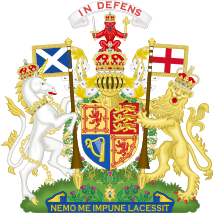 Royal Coat of Arms of the United Kingdom used in Scotland
Royal Coat of Arms of the United Kingdom used in Scotland
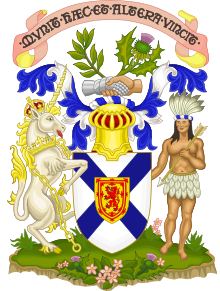 Coat of arms of the Province of Nova Scotia
Coat of arms of the Province of Nova Scotia
Despite the Kingdom of Scotland having been superseded in 1707 by the creation of the Kingdom of Great Britain, elements from both the coat and banner of arms pertaining to the former became incorporated into those of the latter, with a single exception; namely the Royal Standard of Scotland, also known as the Lion Rampant, which is the banner of the ancient arms. This banner, in its original unquartered state, continues to be used officially in Scotland; being flown from royal residences when the Queen is not in residence and used in an official capacity by the First Minister, Lord High Commissioner to the General Assembly of the Church of Scotland, Lord Lyon King of Arms and Lord Lieutenants in their Lieutenancies. Unofficially, the Lion Rampant is commonly used as a second national flag of Scotland, being most often seen at sporting events involving Scottish national teams. (Both the Scottish Football Association and Scotland national football team use a logo based upon the Royal Arms).
Since 1603 the Royal coat of arms as they have appeared in Scotland have undergone numerous changes, however since 1837 the Royal coat of arms of the United Kingdom used in Scotland have remained unchanged; showing the lion of Scotland in the first and fourth quarters of the shield, with those of England in the second and the harp of Ireland in the third. The Scots motto In Defens appears as in the original arms, and the Latin motto of the Order of the Thistle, Nemo me impune lacessit, also appears on a blue scroll overlying the compartment. (The Scots expression Wha Daur Meddle Wi' Me? is regarded as the root of the Latin motto, itself referring to the floral emblem of Scotland, the Thistle, which has sharp spikes at the tips of its leaves resulting in a painful sensation should they be handled without due respect).
Since the Union of the Crowns, these Scottish quarterings have been used for official purposes in Scotland, for example, on official buildings and official publications. The Scotland Office uses a version of the Royal Coat of Arms as used in Scotland and the Crown Office and Procurator Fiscal Service, RCAHMS and the General Register Office for Scotland use a version of the crest.
The banner of the modern arms, the Royal Standard of the United Kingdom used in Scotland, is flown when the Queen is in residence at Balmoral Castle or the Palace of Holyroodhouse, on the queen's car on official journeys and on aircraft (when on the ground). It may also be flown on any building, official or private, during a visit by the Queen, if the owner or proprietor so requests. When the Queen attends the Scottish Parliament in Edinburgh, the Royal Standard of the United Kingdom used in Scotland flies outside the Scottish Parliament Building.
The banner of the Duke of Rothesay features on the 1st and 4th quarters the arms of the Great Steward of Scotland, with the 2nd and 3rd quarters featuring the arms of the Lord of the Isles. In the centre, on an inescutcheon, are the arms of the heir apparent to the King of Scots, namely the Royal arms of Scotland with a three point label. The standard of the Duke of Rothesay is the Royal Standard of Scotland defaced with a three point label.
The Royal Coat of Arms of Canada correspond to those of the United Kingdom in that they also feature the Scottish arms in the second quarter of the shield and use the unicorn as the sinister supporter. The Canadian version also mirrors the Royal Coat of Arms of Scotland in that each supporter not only supports the shield but also a lance displaying a flag.
Both the flag and coat of arms of Nova Scotia feature elements of the Scottish arms. However, unlike the Royal Coat of Arms of Canada, those of Nova Scotia portray the unicorn as the Royally crowned dexter supporter, in the Scottish style. The shield depicts an inverse representation of the flag of Scotland and features the Royal arms of Scotland on an inescutcheon. The motto munit haec et altera vincit appears above the crest in keeping with the Scottish heraldic style. (Both the flag and shield of the Lieutenant Governor of Nova Scotia also feature the Scottish arms on an inescucheon).
The gold shield with double red tressure, with maple leaves (érablé-counter-érablé), is also used in the coat of arms of the Monarchist League of Canada, whose arms were granted by HM The Queen in 2002.
The Scottish arms also feature in the arms of the Lord Lyon King of Arms, the arms of the Royal Scottish Academy and those of the Royal Society of Edinburgh.
See also
- Honours of Scotland
- Kingdom of Great Britain
- Kingdom of Scotland
- Royal coat of arms of the United Kingdom
- Royal Standard of Scotland
- Royal Standard of the United Kingdom
- Scotland
- United Kingdom of Great Britain and Ireland
- United Kingdom of Great Britain and Northern Ireland
References
- ^ Fox-Davies, Charles, The Book of Public Arms (1915), p712
- ^ Coinage of Great Britain. Celtic to Decimalisation, by Ken Elks. Part 12, Scottish Coins.
- ^ Scottish Coins ~ Mary (1542–1567)
- ^ Public Sculpture of Glasgow by Ray McKenzie, Gary Nisbet
- ^ British Monarchy web site
- ^ Heraldry – The Arms of the Earl of Dundee (taken from a book "Scottish Heraldry" by MD Dennis, published in 1999 by the Heraldic Society of Scotland: ISBN 0-9525258-2-8)
Coats of arms of the United Kingdom and dependencies United Kingdom Constituent countries Overseas territories Crown dependencies Royal heraldry in the United Kingdom United Kingdom Royal coat of arms · Royal Standard · Cadency labels of the Royal Family · Imperial State Crown · The Lion and the Unicorn
England Royal Arms · Royal Standards · Honi soit qui mal y pense · Dieu et mon droit · St Edward's Crown · Royal Supporters · Tudor rose · College of ArmsScotland Royal coat of arms · Royal Standard · Nemo me impune lacessit · In My Defens God Me Defend · Crown of Scotland · Court of the Lord LyonWales Monarchy of the United Kingdom · Heraldry  Scotland topics
Scotland topicsHistory Geography Geology · Climate · Demographics · Mountains and hills · Islands · Lochs · Waterfalls · Fauna · Flora · Highlands · Lowlands · Central Belt · Anglo-Scottish borderEconomy Companies · Bank of Scotland · Royal Bank of Scotland · North Sea oil · Whisky · Tourism · Harris Tweed · Renewable energy · Transport · Saltire FoundationLaw People Politics Religion Languages Culture Clans · Cuisine · Education · Flags · Coat of arms · Anthem · Hogmanay · Innovations · Literature · Music · Sport · World Heritage Sites · National identity · National symbols · Scottish surnames Category ·
Category ·  Portal ·
Portal ·  WikiProject
WikiProjectCoats of arms of Europe Sovereign
states- Albania
- Andorra
- Armenia
- Austria
- Azerbaijan
- Belarus
- Belgium
- Bosnia and Herzegovina
- Bulgaria
- Croatia
- Cyprus
- Czech Republic
- Denmark
- Estonia
- Finland
- France
- Georgia
- Germany
- Greece
- Hungary
- Iceland
- Ireland
- Italy
- Kazakhstan
- Latvia
- Liechtenstein
- Lithuania
- Luxembourg
- Macedonia
- Malta
- Moldova
- Monaco
- Montenegro
- Netherlands
- Norway
- Poland
- Portugal
- Romania
- Russia
- San Marino
- Serbia
- Slovakia
- Slovenia
- Spain
- Sweden
- Switzerland
- Turkey
- Ukraine
- United Kingdom
- (England
- Northern Ireland
- Scotland
- Wales)
- Vatican City
States with limited
recognition- Abkhazia
- Kosovo
- Nagorno-Karabakh
- Northern Cyprus
- South Ossetia
- Transnistria
Dependencies
and other territories- Åland
- Faroe Islands
- Gibraltar
- Guernsey
- Jan Mayen
- Jersey
- Isle of Man
- Svalbard
Other entities Categories:- British coats of arms
- National coats of arms
- National symbols of Scotland
- Scottish monarchy
Wikimedia Foundation. 2010.

